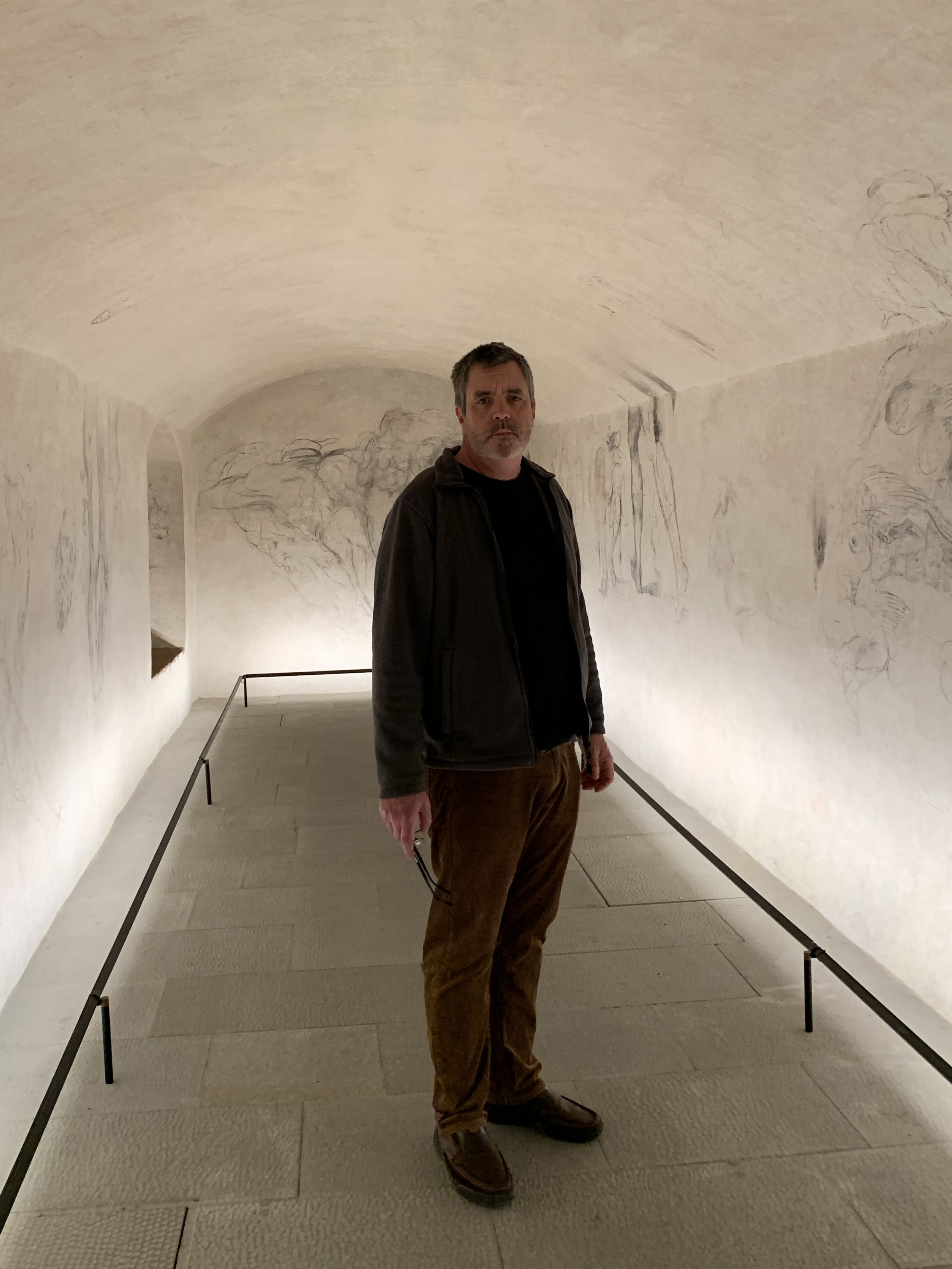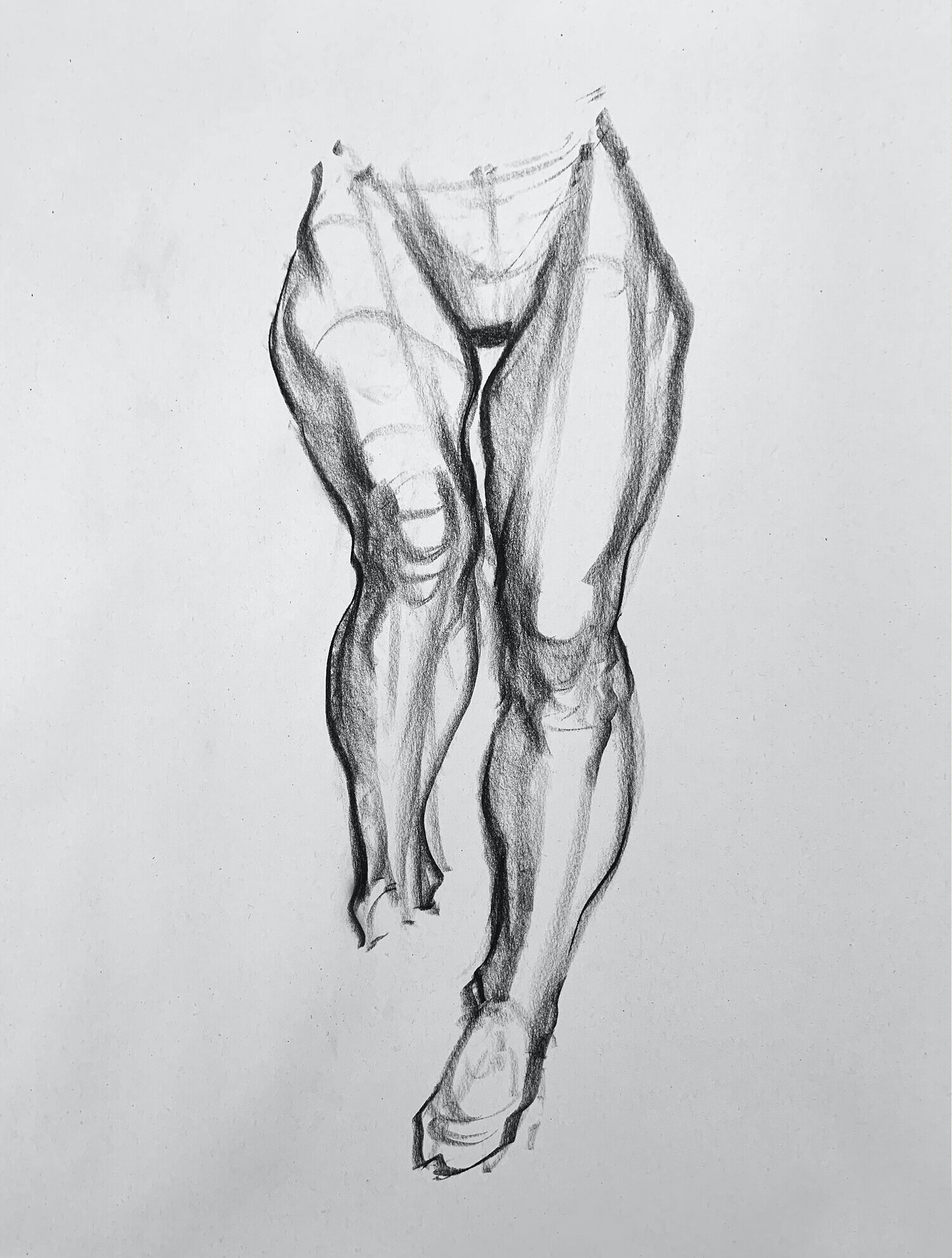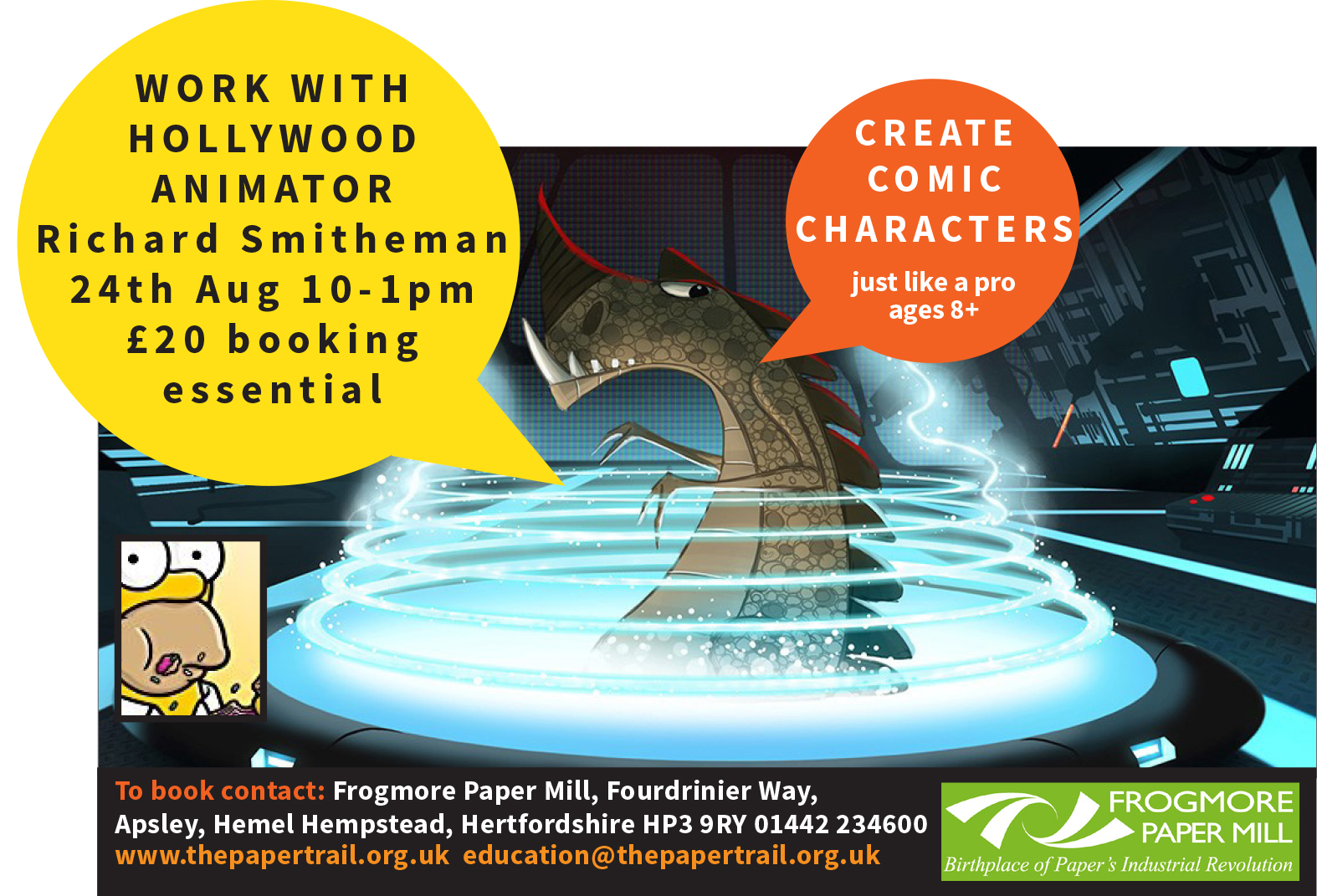While in Florence over the new year I was truly privileged to get a private viewing of 'The Secret Room' in which Michelangelo spent a couple of months hiding for his life. It was a truly profound experience. We also manged to locate the windows of the room from the street, (the last image).
The drawings in the "Secret Room"
When cleaning trials were conducted in a narrow corridor beneath the floor of the New Sacristy that had been used as a charcoal store until 1955 and had lain empty since then, numerous figure sketches of different sizes, drawn in charcoal and sanguine and in many cases overlapping, emerged from beneath two layers of plaster on the walls.
The museum's then Director attributed the majority of them to Michelangelo, surmising that the corridor had been the artist's lair in 1530 when the Prior of San Lorenzo had hidden him from the wrath of Pope Clement VII, who was furious because the artist had been the Republican government's (1527-30) supervisor of fortifications. Granted a pardon after a couple of months, Michelangelo returned to work.
The drawings, which scholars continue to study today, include works now in the Sacristy such as the legs of Giuliano Duke of Nemours, citations of Classical statues such as the head of Laocoön and drawings that can be linked to other sculptures and paintings.
The truth is in the gesture
Success at the gestural (first) stage of the drawing is critical for how the drawing develops in the later stages. This is the point where not only things like rough proportion need to be decided on but it's also where we make the big decisions for the story of the pose. It's much easier to make adjustments at this stage than to try and fix or adjust things down the line. There is a bit of an oxymoron going on here because while we're making all these important decisions that will affect the drawings later development it's also the stage that should feel spontaneous and free, where we bring 'life' to the pose. Good gesture is an art in it's own right and with practice we can learn how to strike that balance.
Drawing from memory
Sometimes when drawing time is limited I’ll do a quick exercise from memory, maybe 10-20 mins in length. I’ll just work through an idea, in this case a leg study but it could be anything really. It’s a great way to gauge how well you know a subject and helps keep the tools sharp. It feels similar and I think has similar rewards to doing scales or exercises on a musical instrument.
Drawing with intention
I think it's really useful to go into a drawing with intention. Before starting a drawing ask yourself what it is you want to say. What speaks to you about the pose and what's the story you want to tell. It's so easy to go into autopilot and just copy what's in front of you. Give yourself that moment to gather your thoughts, then draw!
Time management in drawing
Knowing how long a pose will be and knowing what I can accomplish within a particular time frame is really important for how I approach drawing with a live model.
For example, let's say it's a five minute pose, I think it's reasonable to say that I probably won't get into a fully rendered light and shadow drawing in that amount time, but what about a fifteen or twenty minute pose? Suddenly that question gets harder to answer. I've seen students in class do a lovely line drawing and then with two minutes left on the clock start to add lights and shadow. Ultimately the drawing looks unfinished by the end of the pose whereas two minutes earlier they had a perfectly fine, finished drawing. Ask yourself before you go to the next stage of developing the drawing if you'll have time to get down what you need to before the end of the pose. In the example above with two minutes left on the clock I might quickly 'shadow map' so I can finish the drawing at a later time, or get my tools ready for the next pose.
As you gain experience your intuition for what you can get done in a given time frame will get more refined. I'd suggest timing the pose yourself and not just relying on the tutor or the model to run the clock.
Try and be mindful of the time and what you'll be able to do with it.
I've more to say on this subject but that's for another time!
Sometimes, less is more!
Shorter poses give us the opportunity to get right to the point without getting too fussy or obsessing over the details. When working on shorter poses ask yourself, what's absolutely necessary to tell the story? Everything else is a bonus. 10 min, charcoal on newsprint.
Drawing from reference
When I can't get in front of a live model I practice from photo reference or from memory. It doesn't replace working with a live model, but if you can resist the temptation of just copying a series of shapes and think about the form in three dimensional space, photo's can be a very useful tool for us to keep our skills sharp. It's also useful for working with poses that a model typically wouldn't be able to hold.
Squint and simplify!
I'm always looking for opportunities to simplify the tonal structures and relationships between light and shadow. If we try to capture everything we see, we inevitably end up with too much noise. Simplicity is usually the key. Squinting is a great way to get rid of a lot of the noise and to find the major transitions, just remember to stop squinting before you start drawing!
Learning to draw for Animation.
Dear reader; I first wrote this piece in March 2008 and published it on an old blog of mine. I recently came across it and while many things have changed in the industry since then I still think there are some ideas here of merit for the beginner who’s trying to get together a plan. Enjoy! Richard
Hey Folks,
In the last couple of years I have taken several classes in different areas of art with a view to becoming a better draftsman. With this in mind I wanted to share some of my observations. A disclaimer, I can not possibly cover every subtlety and nuance of what it takes, (I'm not sure I even know yet). By tomorrow I hope to know more than today and consequently this will evolve, but I share my opinions as they stand today.
So what does it take to achieve this goal?
Firstly we have the universally agreed upon disciplines, figure drawing both human and animal, gesture drawing and drawing from life, a study of drapery and clothing and of composition. You may want to add to this list things like acting, cinematography etc. All of these will bring us to one place, which is to communicate an idea or ideas as clearly as possible. So here's some of my observations.
Figure drawing.
When I decided to learn to draw the first thing I did was start to take figure drawing classes. Although there is "gesture drawing" in figure drawing it is on some level a different beast to the gesture drawing we talk about when we consider going to a coffee shop or the likes to draw. The main difference being that in figure drawing we have a controlled environment where the model holds the pose, whether it be thirty seconds or twenty minutes there is a level of control there which is absent in gesture drawing outside of the class, (more on that later). Then we look at the longer poses which require us to be more critical towards volume, anatomy, tone etc. What I find interesting here is the fact that there seems to be a direct coloration between our understanding of anatomy and the level to which we will be able to draw the human form. To be successful in this area requires a fairly formidable understanding of the human form and anatomy, something I was blissfully unaware of before undertaking this and am still trying to learn, never did I think I would learn so much anatomy! There seems to be many people that attempt to draw the human form without this understanding, and it shows. You can't fake it, there is so much going on underneath that is influencing what we see that we simply have to understand it if we are ever to draw the human form with conviction. Once that understanding is there, only then do you become free to draw the figure and rely less on what you see in front of you and more on your knowledge. Then the model becomes more of a leaping off point and the initial slavish copying can stop, a necessary step none the less.
Animal drawing.
Many of the things that apply to figure drawing also apply to animal drawing with one very big difference, the model in animal drawing will not stay still!, and when it does it is invariably sitting in such a way as to make understanding the form extremely difficult. Drawing animals well from life is a very advanced skill and much benefit will be had from studying animals in animal drawing books and from photographic reference(including footage). I know there is controversy to drawing animals from photos but I believe to study from them is a very necessary exercise if you are to really understand there proportions etc, and video footage is critical if one is to understand there gaits and characteristics. I have learnt far more about drawing animals from books and reference material than I have from drawing at the zoo. I found the zoo to be a pretty hostile environment for the artist, from drawing standing up to animals in various states of lethargy and the crowds, not to mention heat, cold and wind. Also we get back to the problem we had in figure drawing but even more amplified which is the fur, hair or feathers which tend to really distort the structure of the animals. Without a good understanding of the anatomy we end up with soft toys! The zoo is a good place to exercise one's academic knowledge but if I were to study animal drawing incrementally I would put drawing at the zoo as the final stage of development and not my starting point. One thing I will say though is if you ever want to gauge how well you really draw then go to the zoo!
Gesture drawing.
I have read and heard many times "carry a sketchbook everywhere you go" and while this is excellent advice there is a small but very valuable piece of information that tends to get left out which is, even though your subject is right in front of you, you are still drawing from your imagination. Everyone is moving all the time so the idea of sitting down in a coffee shop and casually drawing what you observe is really only half of the equation. As someone new to drawing you tend to take the idea of drawing people very literally. You go out and try to capture what you see in front of you, but then you look back and the scene has changed. As a newbie this can throw you. You could go as far as to say that once that initial observation has been made and the pose decided on in your mind that you would be better not to consult the model again for that is likely to throw you off more than it will help. This also applies to the aforementioned zoo drawing. Maybe I'm stating the obvious, but I think it's worth mentioning. It would be fairer to call it "drawing from the imagination on location with reference" but this is a bit wordy!
Master copies.
In the classical atelier tradition making "master copies" from works of the great masters is a important part of development. You can also take this concept and apply it to many different areas of animation such as composition, layout, color theory etc. I forget who said it and am most likely butchering some elegant philosophy but it went something like this "copy the masters enough and eventually this quality will find its way into your own work". Doing copies of poses from model sheets is a tool I have found very useful in helping me refine my drawing. I have found this a great way of learning how the masters pose their characters. It is also very useful for acquiring the skill of drawing on model, more so than with your own character designs which tend to be at the will of your discretion. When copying from model sheets be sure to be very critical of whether you are drawing on model, otherwise this exercise becomes less useful. DO NOT do what I see many people do when they start on a character which is trace the model sheet, (something I have admittedly done in the past), a quick satisfying result that you will learn almost nothing from.
The frame by frame analysis of animation could possibly fall into this category to some extent although your observations would be the end result rather than a copy of a scene. But the spirit remains the same.
So while all of this covers little more than craft I do hope that these observations offer a different perspective in areas I still battle with on a daily basis.
In improvised classical music we study structures for improvisation, scales and exercises and copy our teachers long before the student starts to improvise on their own, and yet in art we seem to jump head first into the improvisation without necessarily acquiring the tools that it requires. Is there a balance? or should there be.
You can teach craft but not art.
Then comes the art.
....I wrote this a couple of weeks ago and have been putting off posting it because I fear I will be criticized for these points of views. After writing this I went back over the Walt Stanchfield notes and felt that maybe all of this was missing the true spirit of drawing. That said these are very real problems I have encountered and therefore have decided to go ahead and throw this up here. This could be considered the first part of a much longer conversation and I hope that at the very least it can start a dialogue about some of the battles we all face in our pursuit to become better artists. In saying that I still believe these points to be fundamentally true, (for me anyway).
Push those proportions!
In Figure Drawing, one of the keys to maintaining vitality and life in a drawing is down to how you handle exaggeration. I always try to push a pose 10% further than what’s in front of me. That way, when the drawing settles down you still have something with life and not a stiff facsimile. This can also apply to proportion. I find it’s a good exercise to push proportion till it ‘almost’ breaks. Sometimes you go too far but but that’s half the fun of it!
The Essence of Life Drawing
FIGURE DRAWING & ANATOMY WORKSHOP, 18TH - 20TH NOVEMBER, FLORENCE.
Character Design Workshop
FROGMORE PAPER MILL, FRIDAY, AUGUST 24TH, 10AM-1PM.
So this should be a bit of fun! Over the three hours we're going to look at Character Design and how we can create compelling characters for Animation, Comics and Children's Books. During the course of the workshop there will be demo's as well as exercises as we look at how to bring personality to the characters we create. This fun and accessible workshop is open to both adults and children, ages 8 and up.
£20 per person. Booking is essential and can be done at Frogmore Paper Mills website at https://www.thepapertrail.org.uk/createacartooncharacter.
Quick Tips #1 Foreshortening
Foreshortening doesn't have to be scary! Here's a simple way to think about it. I'm using a drawing done a few nights ago which I thought would make a good example to demonstrate these ideas. This is part of my thought process as I'm drawing. Hope it helps!
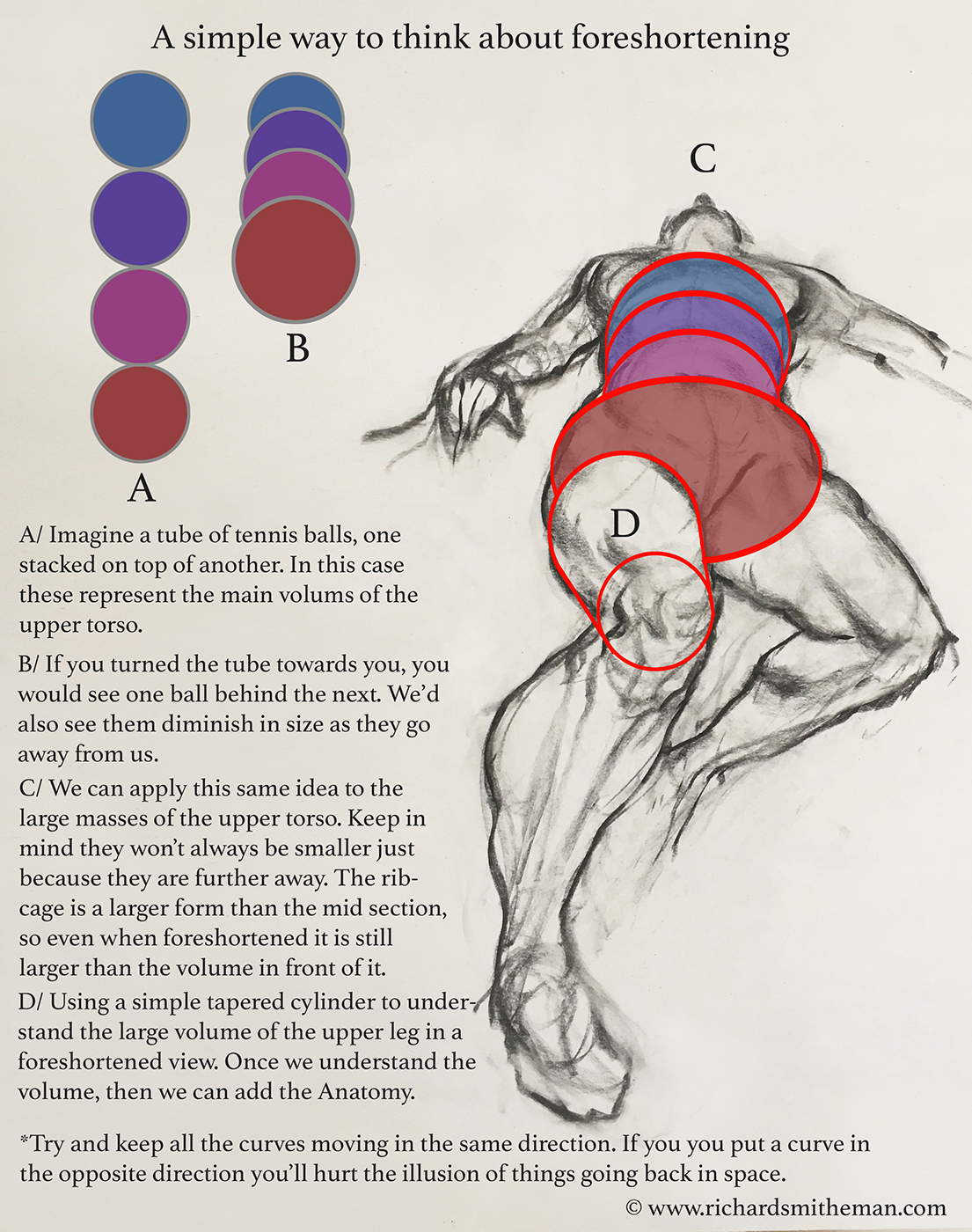
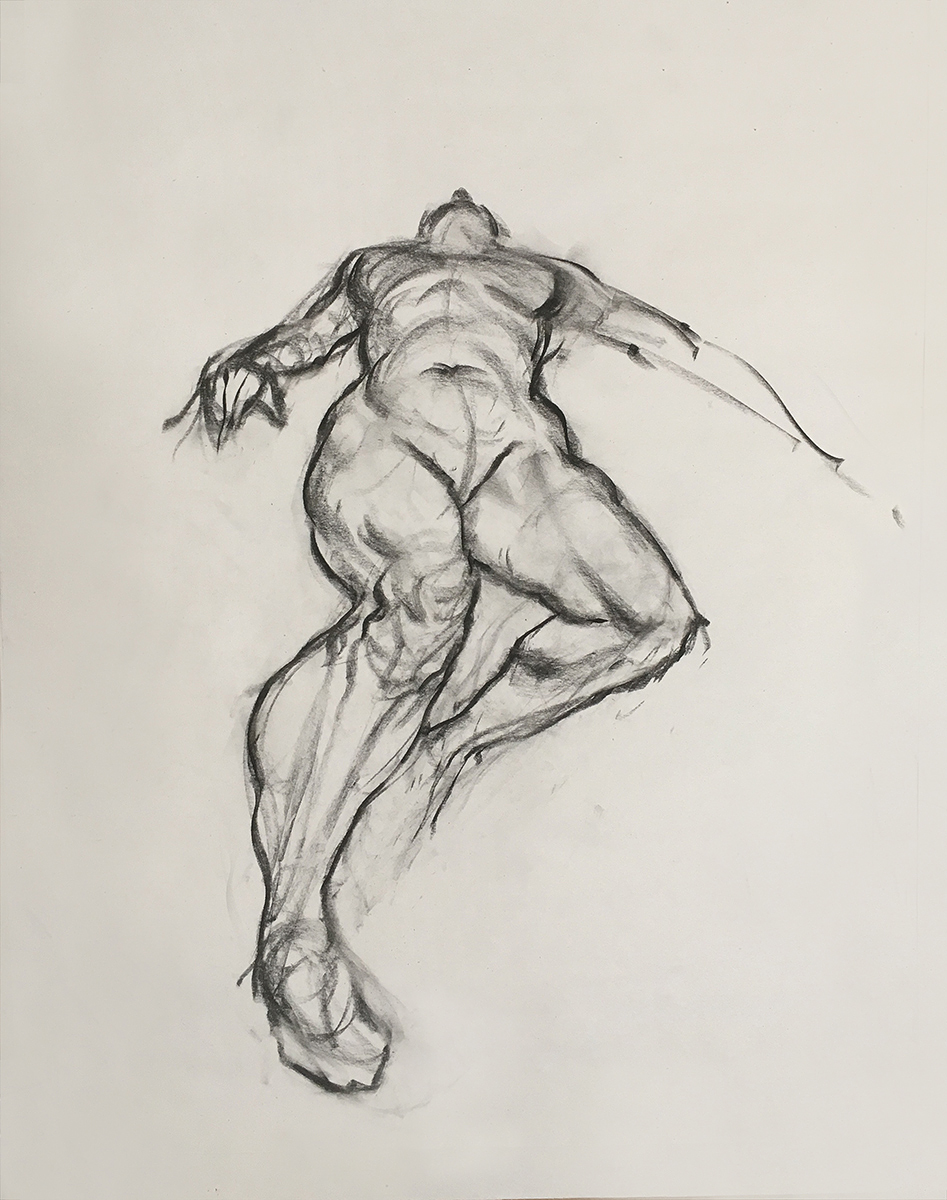
2 Day Life Drawing Workshop at Frogmore Paper Mill
Life Drawing bootcamp starts tomorrow!
This three week bootcamp will help bring your Life Drawing to the next level. Over the 3 weeks we'll look at the different stages for developing solid drawing habits through a variety of techniques, lectures and demos whilst drawing from the model. We’ll discuss design language, transitional forms, foreshortening and a variety of topics that will help develop our drawing.
Anatomy: An Introduction
Some thoughts on Anatomy and why it matters
So many years ago when I started studying figure drawing I had no idea I'd get so immersed in Anatomy! Artistic Anatomy has been an essential component in my development as a Figurative Artist. But understanding Anatomy alone is not enough, it's how we apply those ideas that matters.
So why do we need to learn Anatomy?
Back Anatomy study from écorché. 2018
Well, if we understand what lies beneath the surface we can make some informed decisions on how to represent what we see on the surface. We use anatomical landmarks to help understand and make sense of what it is we are looking at. In turn, we can then make creative decisions on how we want to represent those ideas. When we start to learn Anatomy it can be quite intimidating but it's not essential to know all the names of all the muscles. Knowing some of the major groups and how they relate to each other will go a long way and over time your knowledge will increase and a certain familiarity will start to take hold.
If we break it down into sections, we can make it manageable and develop our understanding in an incremental way without having to get overwhelmed by the whole.
Get out that Anatomy book!
This is a good place to start. Open the anatomy book sitting on your shelf and have it next to you while you draw. If something that you're seeing on the figure needs clarification then you have reference easily at hand. I'll do a book list in a future post where we can look at just a few of what are probably thousands of books on the subject at this point. Another option is obviously google images, but it's a bit more chaotic.
Leg Anatomy study from écorché. 2018
Anatomical study of individual body parts is a great way to familiarise yourself with the patterns and proportions of the muscle systems. Take the torso, an arm, leg or anything that grabs your interest and copy it from the book. Most likely the names of the muscles will be next to them and this will help start to build that knowledge base.
A nice supplement to the above if you have access to one is an écorché. The écorché used for the drawings on this page is a model that sits in my studio. They're not essential by any means, but a nice additional reference.
If you can give just a few minutes a day to Anatomy you'll be amazed how much it will help. As you continue to develop your Figure Drawing you'll have that knowledge to fall back on and help inspire the next decision.
Plenty more to come about Anatomy and how we can apply that knowledge in a meaningful way in future posts!
Gesture Drawing
5 min Gesture from this last week at one of the few sessions where I get to just sit down and draw! Getting those large ideas down quickly gives us a chance to see where we need to adjust before moving further into the drawing. My Life Drawing Bootcamp starts this Tuesday! 3 Tuesday evenings in Covent Garden, should be fun!
